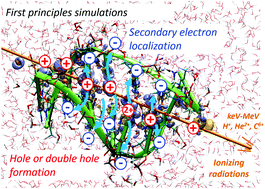当前位置:
X-MOL 学术
›
Phys. Chem. Chem. Phys.
›
论文详情
Our official English website, www.x-mol.net, welcomes your
feedback! (Note: you will need to create a separate account there.)
The physical stage of radiolysis of solvated DNA by high-energy-transfer particles: insights from new first principles simulations.
Physical Chemistry Chemical Physics ( IF 2.9 ) Pub Date : 2020-04-15 , DOI: 10.1039/d0cp00165a Aurelio Alvarez-Ibarra 1 , Angela Parise 2 , Karim Hasnaoui 3 , Aurélien de la Lande 1
Physical Chemistry Chemical Physics ( IF 2.9 ) Pub Date : 2020-04-15 , DOI: 10.1039/d0cp00165a Aurelio Alvarez-Ibarra 1 , Angela Parise 2 , Karim Hasnaoui 3 , Aurélien de la Lande 1
Affiliation

|
The primary processes that occur following direct irradiation of bio-macromolecules by ionizing radiation determine the multiscale responses that lead to biomolecular lesions. The so-called physical stage loosely describes processes of energy deposition and molecular ionization/excitation but remains largely elusive. We propose a new approach based on first principles density functional theory to simulate energy deposition in large and heterogeneous biomolecules by high-energy-transfer particles. Unlike traditional Monte Carlo approaches, our methodology does not rely on pre-parametrized sets of cross-sections, but captures excitation, ionization and low energy electron emission at the heart of complex biostructures. It furthermore gives access to valuable insights on ultrafast charge and hole dynamics on the femtosecond time scale. With this new tool, we reveal the mechanisms of ionization by swift ions in microscopic DNA models and solvated DNA comprising almost 750 atoms treated at the DFT level of description. We reveal a so-called ebb-and-flow ionization mechanism in which polarization of the irradiated moieties appears as a key feature. We also investigate where secondary electrons produced by irradiation localize on chemical moieties composing DNA. We compare irradiation of solvated DNA by light (H+, and He2+) vs. heavier (C6+) ions, highlighting the much higher probability of double ionization with the latter. Our methodology constitutes a stepping stone towards a greater understanding of the chemical stage and more generally towards the multiscale modelling of radiation damage in biology using first principles.
中文翻译:

高能转移粒子对溶解的DNA进行放射分解的物理阶段:新的第一原理模拟的见解。
通过电离辐射直接辐照生物大分子之后发生的主要过程决定了导致生物分子损伤的多尺度响应。所谓的物理阶段粗略地描述了能量沉积和分子电离/激发的过程,但仍然难以捉摸。我们提出了一种基于第一原理密度泛函理论的新方法,以模拟通过高能传递粒子在大而异质生物分子中的能量沉积。与传统的蒙特卡洛方法不同,我们的方法不依赖预先设定的横截面集,而是在复杂生物结构的核心捕获激发,电离和低能电子发射。此外,它还提供了有关飞秒时间尺度上超快电荷和空穴动力学的有价值的见解。使用这个新工具,我们揭示了微观DNA模型中快速离子的电离机制以及在描述的DFT级别处理的包含近750个原子的溶剂化DNA。我们揭示了一种所谓的潮起潮落电离机制,其中被辐射部分的极化是关键特征。我们还研究了辐射产生的二次电子在组成DNA的化学部分上的位置。我们比较了光(H +和He2 +)与较重的(C6 +)离子对溶剂化DNA的辐照,强调了后者发生双电离的可能性更高。我们的方法学构成了迈向深入了解化学阶段,更普遍地迈向使用第一原理进行生物学辐射损伤多尺度建模的垫脚石。我们揭示了微观DNA模型中速溶离子的电离机理,以及在描述的DFT水平下包含近750个原子的溶剂化DNA。我们揭示了一种所谓的潮起潮落电离机制,其中被照射部分的极化是关键特征。我们还研究了辐射产生的二次电子在组成DNA的化学部分上的位置。我们比较了光(H +和He2 +)与较重的(C6 +)离子对溶剂化DNA的辐照,强调了后者发生双电离的可能性更高。我们的方法论构成了迈向深入了解化学阶段,更普遍地迈向使用第一原理进行生物学辐射损伤多尺度建模的垫脚石。我们揭示了微观DNA模型中速溶离子的电离机理,以及在DFT描述水平下处理的包含近750个原子的溶剂化DNA。我们揭示了一种所谓的潮起潮落电离机制,其中被照射部分的极化是关键特征。我们还研究了辐射产生的二次电子在何处位于组成DNA的化学部分上。我们比较了光(H +和He2 +)与较重的(C6 +)离子对溶剂化DNA的辐照,强调了后者发生双电离的可能性更高。我们的方法论构成了迈向深入了解化学阶段,更普遍地迈向使用第一原理进行生物学辐射损伤多尺度建模的垫脚石。
更新日期:2020-04-15
中文翻译:

高能转移粒子对溶解的DNA进行放射分解的物理阶段:新的第一原理模拟的见解。
通过电离辐射直接辐照生物大分子之后发生的主要过程决定了导致生物分子损伤的多尺度响应。所谓的物理阶段粗略地描述了能量沉积和分子电离/激发的过程,但仍然难以捉摸。我们提出了一种基于第一原理密度泛函理论的新方法,以模拟通过高能传递粒子在大而异质生物分子中的能量沉积。与传统的蒙特卡洛方法不同,我们的方法不依赖预先设定的横截面集,而是在复杂生物结构的核心捕获激发,电离和低能电子发射。此外,它还提供了有关飞秒时间尺度上超快电荷和空穴动力学的有价值的见解。使用这个新工具,我们揭示了微观DNA模型中快速离子的电离机制以及在描述的DFT级别处理的包含近750个原子的溶剂化DNA。我们揭示了一种所谓的潮起潮落电离机制,其中被辐射部分的极化是关键特征。我们还研究了辐射产生的二次电子在组成DNA的化学部分上的位置。我们比较了光(H +和He2 +)与较重的(C6 +)离子对溶剂化DNA的辐照,强调了后者发生双电离的可能性更高。我们的方法学构成了迈向深入了解化学阶段,更普遍地迈向使用第一原理进行生物学辐射损伤多尺度建模的垫脚石。我们揭示了微观DNA模型中速溶离子的电离机理,以及在描述的DFT水平下包含近750个原子的溶剂化DNA。我们揭示了一种所谓的潮起潮落电离机制,其中被照射部分的极化是关键特征。我们还研究了辐射产生的二次电子在组成DNA的化学部分上的位置。我们比较了光(H +和He2 +)与较重的(C6 +)离子对溶剂化DNA的辐照,强调了后者发生双电离的可能性更高。我们的方法论构成了迈向深入了解化学阶段,更普遍地迈向使用第一原理进行生物学辐射损伤多尺度建模的垫脚石。我们揭示了微观DNA模型中速溶离子的电离机理,以及在DFT描述水平下处理的包含近750个原子的溶剂化DNA。我们揭示了一种所谓的潮起潮落电离机制,其中被照射部分的极化是关键特征。我们还研究了辐射产生的二次电子在何处位于组成DNA的化学部分上。我们比较了光(H +和He2 +)与较重的(C6 +)离子对溶剂化DNA的辐照,强调了后者发生双电离的可能性更高。我们的方法论构成了迈向深入了解化学阶段,更普遍地迈向使用第一原理进行生物学辐射损伤多尺度建模的垫脚石。











































 京公网安备 11010802027423号
京公网安备 11010802027423号